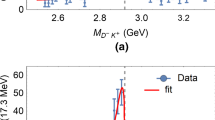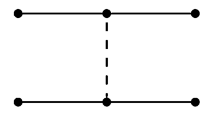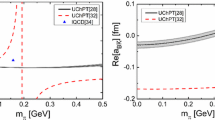Abstract
A solvable coordinate-space model is employed to study the \(c\bar{c}\) component of the X(3872) wave function, by coupling a confined 3 P 1 \(c\bar {c}\) state to the almost unbound S-wave \(D^{0}\overline{D}^{*0}\) channel via the 3 P 0 mechanism. The two-component wave function is calculated for different values of the binding energy and the transition radius a, always resulting in a significant \(c\bar{c}\) component. However, the long tail of the \(D^{0}\overline{D}^{*0}\) wave function, in the case of small binding, strongly limits the \(c\bar{c}\) probability, which roughly lies in the range 7–11 %, for the average experimental binding energy of 0.16 MeV and a between 2 and 3 GeV−1. Furthermore, a reasonable value of 7.8 fm is obtained for the X(3872) r.m.s. radius at the latter binding energy, as well as an S-wave \(D^{0}\overline{D}^{*0}\) scattering length of 11.6 fm. Finally, the \(\mathcal{S}\)-matrix pole trajectories as a function of coupling constant show that X(3872) can be generated either as a dynamical pole or as one connected to the bare \(c\bar{c}\) confinement spectrum, depending on details of the model. From these results we conclude that X(3872) is not a genuine meson–meson molecule, nor actually any other mesonic system with non-exotic quantum numbers, due to inevitable mixing with the corresponding quark–antiquark states.




Similar content being viewed by others
Notes
Henceforth, we omit the bar in \(D\overline{D}^{*}\), for notational simplicity.
References
S.K. Choi et al. (Belle Collaboration), Phys. Rev. Lett. 91, 262001 (2003)
D. Acosta et al. (CDF Collaboration), Phys. Rev. Lett. 93, 072001 (2004)
V.M. Abazov et al. (D0 Collaboration), Phys. Rev. Lett. 93, 162002 (2004)
B. Aubert et al. (BABAR Collaboration), Phys. Rev. D 71, 071103 (2005)
B. Aubert et al. (BABAR Collaboration), Phys. Rev. D 73, 011101 (2006)
R. Aaij et al. (LHCb Collaboration), Eur. Phys. J. C 72, 1972 (2012)
J. Beringer et al. (Particle Data Group Collaboration), Phys. Rev. D 86, 010001 (2012)
A. Abulencia et al. (CDF Collaboration), Phys. Rev. Lett. 98, 132002 (2007)
V. Bhardwaj et al. (Belle Collaboration), Phys. Rev. Lett. 107, 091803 (2011)
P. del Amo Sanchez et al. (BABAR Collaboration), Phys. Rev. D 82, 011101 (2010)
Y. Fan, J.-Z. Li, C. Meng, K.-T. Chao, Phys. Rev. D 85, 034032 (2012)
T. Wang, G.-L. Wang, Y. Jiang, W.-L. Ju, arXiv:1205.5725 [hep-ph]
C.-Y. Cui, Y.-L. Liu, G.-B. Zhang, M.-Q. Huang, Commun. Theor. Phys. 57, 1033 (2012)
N.A. Tornqvist, Phys. Lett. B 590, 209 (2004)
N.A. Tornqvist, Z. Phys. C 61, 525 (1994)
N.A. Tornqvist, Phys. Rev. Lett. 67, 556 (1991)
S. Coito, G. Rupp, E. van Beveren, Eur. Phys. J. C 71, 1762 (2011)
K.K. Seth, Prog. Part. Nucl. Phys. 67, 390 (2012)
E. Braaten, M. Lu, Phys. Rev. D 76, 094028 (2007)
E. Braaten, M. Kusunoki, Phys. Rev. D 69, 074005 (2004)
E. van Beveren, G. Rupp, Ann. Phys. 324, 1620 (2009)
E. van Beveren, G. Rupp, Int. J. Theor. Phys. Group Theory Nonlinear Opt. 11, 179 (2006)
E. van Beveren, C. Dullemond, T.A. Rijken, Z. Phys. C 19, 275 (1983)
S. Coito, G. Rupp, E. van Beveren, Acta Phys. Pol. B, Proc. Suppl. 5, 1015 (2012)
E. van Beveren, T.A. Rijken, K. Metzger, C. Dullemond, G. Rupp, J.E. Ribeiro, Z. Phys. C 30, 615 (1986)
E. van Beveren, G. Rupp, T.A. Rijken, C. Dullemond, Phys. Rev. D 27, 1527 (1983)
A.M. Badalian, V.D. Orlovsky, Y.A. Simonov, arXiv:1210.4674 [hep-ph]
E. van Beveren, G. Rupp, arXiv:0712.1771 [hep-ph]
G.S. Bali et al. (SESAM Collaboration), Phys. Rev. D 71, 114513 (2005)
E. van Beveren, G. Rupp, Phys. Rev. Lett. 91, 012003 (2003)
A.M. Badalian, V.D. Orlovsky, Y.A. Simonov, B.L.G. Bakker, Phys. Rev. D 85, 114002 (2012)
P.G. Ortega, J. Segovia, D.R. Entem, F. Fernandez, Phys. Rev. D 81, 054023 (2010)
M. Takizawa, S. Takeuchi, arXiv:1206.4877 [hep-ph]
E. van Beveren, G. Rupp, Phys. Rev. Lett. 97, 202001 (2006)
E. van Beveren, G. Rupp, Eur. Phys. J. A 31, 468 (2007)
M.B. Voloshin, Prog. Part. Nucl. Phys. 61, 455 (2008)
A.G.M. Verschuren, C. Dullemond, E. van Beveren, Phys. Rev. D 44, 2803 (1991)
D. Gamermann, J. Nieves, E. Oset, E. Ruiz Arriola, Phys. Rev. D 81, 014029 (2010)
F. Aceti, R. Molina, E. Oset, Phys. Rev. D 86, 113007 (2012)
Bateman Manuscript Project, in Higher Transcendental Functions, vol. 1, ed. by A. Erdelyi et al. (McGraw-Hill, New York, 1953). Chap. VI
M. Abramowitz, I.A. Stegun (eds.), Handbook of Mathematical Functions, with Formulas, Graphs, and Mathematical Tables, 9th edn. (Dover, New York, 1970). Chap. 6
Acknowledgements
One of us (G.R.) is indebted to R.M. Woloshyn for the invitation to a most stimulating miniworkshop at TRIUMF last year, where the topic leading to the present paper was debated. Thanks are also due to E. Braaten and K.K. Seth for very useful discussions on X(3872). This work was partially supported by the Fundação para a Ciência e a Tecnologia of the Ministério da Educação e Ciência of Portugal, under contract no. CERN/FP/123576/2011.
Open Access
This article is distributed under the terms of the Creative Commons Attribution License which permits any use, distribution, and reproduction in any medium, provided the original author(s) and the source are credited.
Author information
Authors and Affiliations
Corresponding author
Appendices
Appendix A: Solving the coupled-channel Schrödinger equation
We twice integrate the Schrödinger equation (5) in order to get two sets of boundary conditions, viz. Eqs. (A.1) and (A.2):


A general solution to this problem is the two-component wave function given by Eqs. (A.3) and (A.4), for the confined and meson–meson channel, respectively:

In Eq. (A.3), the function F c (r) vanishes at the origin, whereas G c (r) falls off exponentially for r→∞, their explicit expressions being


where Φ and Ψ are the confluent hypergeometric functions of first and second kind (see Appendix B), respectively, Γ(−ν) is the complex gamma function, ν is given by Eq. (6), and z=μωr 2. Note that only in the case of integer ν, i.e., for g=0, do Φ and Ψ reduce to the usual Laguerre polynomials for the three-dimensional HO potential. Furthermore, the functions J and N in Eq. (A.4) are simple redefinitions of the standard spherical Bessel and Neumann functions, i.e., J l (kr)=k −l rj l (kr) and N l (kr)=k l+1 rn l (kr). From the boundary conditions (A.1) and (A.2), as well as the wave-function expressions (A.3) and (A.4), we get, with the definition κ=ka,

Using now the Wronskian relations

and continuity of the wave function at r=a (cf. Eq. (A.2)), we can solve for three of the four unknowns A c , B c , A f , and B f . Note that Eqs. (A.1) and (A.2) are not entirely linearly independent, so that solving all four constants is not possible. This is logical, as the overall wave-function normalization does not follow from the Schrödinger equation. Expressing all in terms of A c then yields
Note that, in order to obtain the D 0 D ∗0 wave function in the outer region, we must substitute \(\cot \delta_{l_{f}}(E) =i\) in Eq. (A.4) (also see below). Finally, the normalization constant \(\mathcal{N}\) of the total wave function is determined by computing
Then, we can also calculate the root-mean-square radius \(\bar{r}=\sqrt{\langle r^{2}\rangle}\) of the two-component system by
As for the \(\mathcal{S}\)-matrix poles corresponding to resonances, bound states, or virtual bound states, \(\cot \delta_{l_{f}} (E)\) can be solved from continuity of u f (r) at r=a in Eq. (A.4), resulting in the expression
with the 1×1 \(\mathcal{S}\)-matrix simply given by
Real or complex poles can then be searched for numerically, by using Newton’s method to find the energies for which \(\cot \delta_{l_{f}}(E)=i\), on the appropriate Riemann sheet.
Appendix B: Special functions, numerical methods, and kinematics
The confluent hypergeometric functions Φ and Ψ introduced in Appendix A are defined in Ref. [40], Eqs. (6.1.1) and (6.5.7), respectively. Thus, the function Φ is easily programmed as a rapidly converging power series, while the definition (6.5.7) of Ψ in terms of Φ and the gamma function Γ then also allows straightforward computation, by employing Gauss’s multiplication formula for Γ(−ν) (see Ref. [41], Eq. (6.1.20)) so as to map the argument −ν to lying well inside the unit circle in the complex plane, whereafter a very fast converging power-series expansion of 1/Γ(−ν) (see Ref. [41], Eq. (6.1.34)) can be applied.
The integrals for wave-function normalization and computation of r.m.s. radii are carried out by simple Gauss integration, choosing increasing numbers of points on a finite interval for the \(c\bar{c}\) channel, and an infinite one for D 0 D ∗0. Note that, in the former case, the wave function falls off fast enough to allow convergence for a finite cutoff, whereas in the latter a suitable logarithmic mapping is used. In both cases though, because of the wave-function cusp at r=a and in order to avoid numerical instabilities, the domain of integration is split into two pieces, with up to 16 Gauss points in the inner region and 64 in the outer one, thus resulting in a very high precision of the results.
Although the X(3872) bound state can reasonably be considered a nonrelativistic system, we still use relativistic kinematics in the D 0 D ∗0 channel, since parts of the resonance-pole trajectories involve relatively large (complex) momenta. For consistency, the same is done for all energies. The manifest unitarity of the \(\mathcal{S}\) matrix is not affected by this choice. Thus, the relative D 0 D ∗0 momentum reads
where T and P are the threshold (\(m_{D^{*0}}+m_{D^{0}}\)) and pseudothreshold (\(m_{D^{*0}}-m_{D^{0}}\)) energies, respectively. The corresponding relativistic reduced mass is defined as
Note that in the \(c\bar{c}\) channel the reduced mass is defined in the usual way, i.e., μ c =m c /2, owing to the inherently nonrelativistic nature of the HO potential and the ensuing wave function.
Rights and permissions
About this article
Cite this article
Coito, S., Rupp, G. & van Beveren, E. X(3872) is not a true molecule. Eur. Phys. J. C 73, 2351 (2013). https://doi.org/10.1140/epjc/s10052-013-2351-8
Received:
Revised:
Published:
DOI: https://doi.org/10.1140/epjc/s10052-013-2351-8




